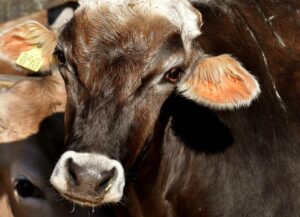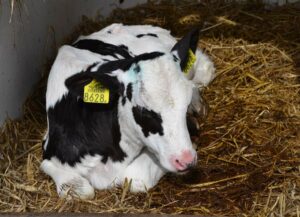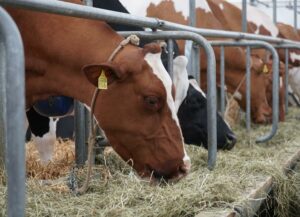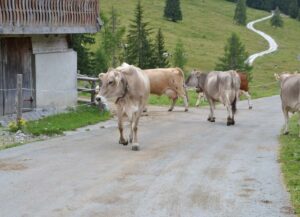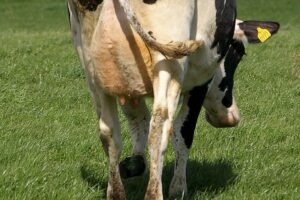Alvaro Garcia
Maintaining an adequate concentration of calcium in blood during the transition period is very important. The start of a new lactation challenges the cow’s ability to maintain normal blood calcium. Colostrum and milk are very rich in calcium, and cows must quickly adjust to these sudden losses. Second and greater lactation cows are generally more affected by this drastic calcium decline.
There is a subclinical form of hypocalcemia that can progress into the clinical form. In the subclinical form the signs are more subtle and difficult to detect, however the earlier its detection the greater the chances for a successful treatment. When a cow becomes recumbent, we are already likely in presence of clinical hypocalcemia.
The subclinical form predisposes to other metabolic diseases. Slight drops in blood calcium concentrations lead to reductions in feed intake, decreased smooth muscle (internal organs) tone, and increased incidence of retained fetal membranes, displaced abomasum, and mastitis. A critical step to maintain adequate blood calcium levels is to achieve an equilibrium between positive and negative ions. The balance between cations (positive charge) and anions (negative charge) should tend to neutrality.
What is the key to maintain blood calcium levels in dairy cows?
When considering close-up cow diets however it is recommended that the dietary ionic balance be negative (more anions than cations) because a negative balance leads to more calcium mobilization and absorption. Bone metabolic markers in blood have been used to monitor the adequacy of Ca mobilization in dairy cows during the transition period. One example is osteoprotegerin, an anti-resorptive protein that downregulates osteoclast differentiation in the bone.
Tartrate-resistant acid phosphatase (TRAP5b) secreted by the osteoclasts provides a good assessment of the number of these active cells present. Since osteoprotegerin downregulates the activity of osteoclasts, it is logical to expect that its concentration will be reduced at calving. The differentiation of the osteoclasts is triggered by calving and regulated by the inducer of its ligand called RANKL (nuclear activator NF-κB ligand) that acts as its inhibitor. From this perspective then the osteoprotegerin/RANKL ratio reflects the amount of bone resorption occurring and the amount of calcium in circulation.
A recent experiment (Hatate et al. 2020) assessed these osteoclast-related markers in peri-parturient cows of different parities and those that had hypocalcemia. The markers measured were osteoprotegerin and tartrate-resistant acid phosphatase 5b (TRAP5b).
Holstein cows in parturition with an age range of 1.8 –7.6 years were included in the experiment. All cows were entering their first, second, third, fourth (or greater) parities. Cows were fed a TMR containing corn and grass silage, concentrate mix, vitamins, and minerals and had access to water and hay ad libitum.
Diets had normal composition ranges typically fed to transition dairy cows. Blood biochemistry was performed during the 3 weeks prepartum (−21, −14, and − 7 days) and within 16 h of calving and 2–5 d after calving. Seven cows developed hypocalcemia at the third, fourth, and fifth parities, whereas the remaining cows at their third or greater parities did not show any signs of it.
Could we predict the risk of hypocalcemia in cows by measuring osteoprogeterin and TRAP5b levels in blood?
Blood Ca concentration at calving was significantly lower for cows in their third (6.9 ± 0.4 mg/dL) and fourth parities + (7.0 ± 0.6 mg/dL), compared to cows in their first parity (8.6 ± 0.3 mg/dL). Only cows in their second parity showed a significant reduction in serum osteoprotegerin concentration from −7 d to post calving (4.1–5.0 ng/mL), compared to −21 d (7.8 ± 0.8 ng/mL).
The blood TRAP5b concentrations increased significantly after calving in cows of all parities (P1, 2.7 ± 0.3; P2, 1.5 ± 0.1; P3, 1.3 ± 0.1; P4+, 1.6 ± 0.1 U/L); the concentration in cows at P1 was higher than those of other parities. First parity cows had a significantly lower osteoprotegerin/tartrate-resistant acid phosphatase ratio than multiparous cows; cows at P2 and P3 showed declines from −21 to −7 d (P2: from 7.9 ±1.1 to 5.1 ± 0.6 μg/U) and from −14 d to post calving (P3, from 7.0 ± 1.4 to 3.7 ± 0.8 μg/U, respectively. However, osteoprotegerin/tartrate-resistant acid phosphatase ratio in cows at P4 or higher remained constant throughout the experiment (4.3 – 7.2 μg/U).
The reduction in the serum Ca concentration at calving was greater in cows with milk fever than in healthy cows (5.4 ± 0.7 vs.7.5 ± 0.3 mg/dL). Serum osteoprotegerin concentrations remained the same, while the blood TRAP5b concentration increased at calving in healthy cows and post calving in cows with hypocalcemia.
In healthy cows only the osteoprotegerin/tartrate-resistant acid phosphatase ratio decreased significantly at calving (3.6 ± 0.9 μg/U). The osteoprotegerin/tartrate-resistant acid phosphatase ratio at calving was not significantly correlated with parity for all cows. However, when only multiparous cows were included (P2 to P4+) they were inversely correlated with parity (ρ = −0.50).
The osteoprotegerin/tartrate-resistant acid phosphatase ratio at calving was not different between hypocalcemic and healthy cows. Osteoprotegerin concentrations did not differ between primiparous and multiparous cows. However, P1 cows had higher blood TRAP5b activity, this can be explained because the bones in these cows are still in active growth with greater cell turnover.
The osteoprotegerin/tartrate-resistant acid phosphatase ratio levels during the 3 weeks before calving differed among parities; older multiparous cows with more severe hypocalcemia appeared to lack a trigger for osteoprotegerin differentiation immediately before calving. Moreover, the osteoprotegerin/tartrate-resistant acid phosphatase ratio reduction was less pronounced in hypocalcemic cows.
These results suggest that the osteoprotegerin/tartrate-resistant acid phosphatase and the TRAP5b ratios may be new indexes to predict hypocalcemia in dairy cows. Improving pre-calving osteoclast differentiation helps reduce the incidence of milk fever.
Reference
K. Hatate, C. Kawashima, M. Kayano, M. Hanada, N. Yamagishi. Blood Markers of Osteoclastic Differentiation in Periparturient Dairy Cows at Different Parities, With and Without Milk Fever. Res Vet Sci. 2020 Aug;131:301-305.
© 2020 Dairy Knowledge Center. All Rights Reserved.



